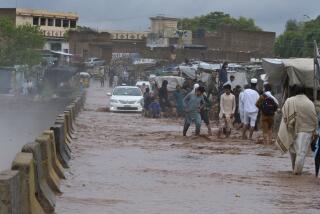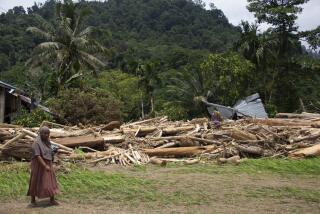Migration of monsoons created, then killed Harappan civilization
The slow eastward migration of monsoons across the Asian continent initially supported the formation of the Harappan civilization in the Indus valley by allowing production of large agricultural surpluses, then decimated the civilization as water supplies for farming dried up, researchers reported Monday. The results provide the first good explanation for why the Indus valley flourished for two millennia, sprouting large cities and an empire the size of contemporary Egypt and Mesopotamia combined, then dwindled away to small villages and isolated farms.
The Harappan civilization, named after its largest city, Harappa along the upper Indus River, evolved beginning about 5,200 years ago and reached its height between 4,500 and 3,900 years ago, stretching across what is now Pakistan, northwest India and Eastern Afghanistan. An urban society with large cities, a distinctive style of writing and extensive trade that reached as far as Mesopotamia, the society accounted for about 10% of the Earth’s population at its height and rivaled Egypt in its power. Unlike Egypt and Mesopotamia, however, the Harappans did not attempt to develop irrigation to support agriculture. Instead, they relied on the annual monsoons, which allowed the accumulation of large agricultural surpluses -- which, in turn, allowed the creation of cities. The civilization was largely forgotten by history until the 1920s, when researchers finally began studying it in depth.
The new research was performed by a team led by geologist Liviu Giosan of the Woods Hole Oceanographic Institution in Woods Hole, Mass., and published in the Proceedings of the National Academy of Science. Working in Pakistan, they used photographs taken by shuttle astronauts and images from the Shuttle Radar Topography Mission to prepare maps of land forms in the region, then verified them on the ground using drilling, coring and manually dug trenches.
Before the region was settled, regular and powerful monsoons flooded the Indus River and its tributaries, moving large amounts of sediment across the plains and cutting deep valleys through the deposits. One of the most striking features the researchers found was a mounded plain, 10 to 20 yards high, more than 60 miles wide and running almost 600 miles along the Indus. The rich silt deposited by the river was perfect for agriculture, the team said.
By about 5,500 years ago, however, the monsoon area had drifted eastward and the devastating floods along the Indus were replaced by overflows that watered the soil and encouraged agriculture. “The Harappans were an enterprising people taking advantage of a window of opportunity -- a kind of ‘Goldilocks civilization,’” Giosan said. “As monsoon drying subdued devastating floods, the land nearby the rivers -- still fed with water and rich silt -- was just right for agriculture.”
But as the monsoons continued their eastward drift, the annual floods became weaker and less regular and the Harappan agriculture could no longer support the large cities. Beginning around 3,900 years ago, communities of farmers followed the monsoons to the East, forming small villages along the river that relied on the local rains. Those rains did not support a large agricultural surplus, Giosan said. The cities died out, the writing was lost, trade halted and the Harappan civilization was no more.
The team also believes that they have solved another mystery, the fate of the mythical river the Sarasvati. The ancient Indian scriptures called the Veda described the Sarasvati as “surpassing in might and majesty all other waters” and “pure in her course from the mountains to the ocean.” Those writings suggest that the Sarasvati was fed by Himalayan glaciers and flowed to the ocean. But the new data indicatethat there was no river during the period fed by glaciers, only those fed by the annual monsoons. If, indeed, there was a Sarasvati, it was a monsoonal river just like the others.
LATimesScience@gmail.com
Twitter/@LATMaugh






